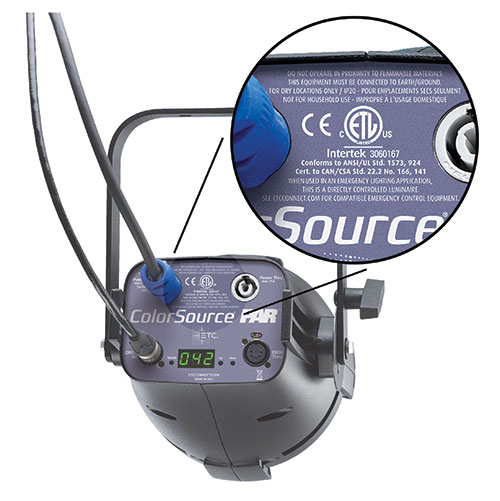As new technologies are developed and those technologies are used in new ways, codes and standards evolve to insure the safety of the public. In response to the appearance on the market of more complex emergency luminaires and emergency control systems, the 2014 National Electrical Code® added a new section that will have a long-term profound effect on the design and specification of emergency lighting systems:
700.24 Directly Controlled Luminaires. Where emergency illumination is provided by one or more directly controlled luminaires that respond to an external control input to bypass normal control upon loss of normal power, such luminaires and external bypass controls shall be individually listed for use in emergency systems.
Unfortunately, the 2014 NEC contained no definition of a directly controlled luminaire. That definition was added in the 2017 NEC:
Luminaire, Directly Controlled. An emergency luminaire that has a control input for an integral dimming or switching function that drives the luminaire to full illumination upon loss of normal power.
Informational Note: See ANSI/UL 924, Emergency Lighting and Power Equipment, for information covering directly controlled luminaires.
The delayed appearance of the above definition resulted in confusion on the part of designers, specifiers, luminaire/ driver manufacturers, and authorities having jurisdiction (AHJs) as to how to comply with the requirements of NEC section 700.24. This situation was exacerbated by two trending developments: the increasing use of dimming LED luminaires in new system designs, and the desire of designers and specifiers to utilize the same dimming luminaire for both normal and emergency illumination—when normal power is present, it provides normal illumination; but when normal power is lost, it becomes a code-compliant emergency luminaire. In addition, the move away from lighting control via centralized dimming systems and toward luminaires containing integral dimming or switching functionality has increased the importance of compliance with section 700.24.
Historical Perspective
For many years, luminaire types used for normal illumination have also been used for emergency illumination in compliance with NEC article 700. The reason is clear: from an aesthetic point-of view, emergency use of normal luminaires provided designers with a visually pleasing solution that eliminated dark luminaires during normal operation, and eliminated the need for unit equipment that often clashed with the visual design of a facility. In addition, when these normal/emergency luminaires used simple line-voltage tungsten or fluorescent sources, there were no special compliance requirements added to the luminaires themselves when used for emergency lighting. Rather, compliance with NEC article 700 was left to the control equipment responsible for energizing the luminaire upon loss of normal power. Most often, this was a simple UL924 Listed automatic load control relay (ALCR) that was used to bypass normal line-voltage switch control and energize the luminaire, or a UL1008 listed transfer switch that transferred the luminaire from a normal branch circuit to an emergency branch circuit. The luminaire itself was simple, without complex electronic circuitry or internal control functionality. Therefore, it would reliably illuminate when power was applied. The result was that simple luminaires of this type generally had no separate emergency listing in order to provide emergency illumination in a Code-compliant manner.
The Effect of LED Luminaires
As LED luminaires have begun to dominate the market, built-in dimming or switching functionality via a control input to the luminaire has fast become the norm. These control inputs include 0-10V (aka 1-10V), DALI, DMX512, and normal power sensing, among others. This creates a materially different compliance situation: the intelligent luminaire and its more complex internal control functionality must now function reliably and predictably in order to insure the presence of emergency illumination upon loss of normal power. The result was the creation of NEC section 700.24 and its requirement that any luminaire with a control input that is utilized for emergency illumination is now a directly controlled luminaire as defined in section 700.2, and must therefore be listed as Emergency Lighting and Power Equipment under UL924. That includes luminaires with drivers using 0-10V control that often previously relied on the control system (or an ALCR with appropriate functionality) to disconnect the control circuit from the driver, which generally forces the luminaire to Full On.
Those 0-10V control inputs now qualify the driver or luminaire as a Directly Controlled Luminaire that must be UL924 Listed. This control-disconnect method is also used with DALI, but the result can be less predictable since a DALI driver’s response to loss of control signal is programmable, i.e., loss of signal could actually turn lights off rather than forcing them to Full On. Note that some control systems will provide an active Full On control signal upon loss of normal power rather than using the control-disconnect method above.

Are simple line-dimmed LED luminaires Directly Controlled Luminaires?
The question often comes up as to whether a line-dimmed LED luminaire is a Directly Controlled Luminaire and subject to the UL924 listing requirement of section 700.24. Here are the reasons why line-dimmed luminaires do not generally need a UL924 listing:
- A simple line dimmed luminaire of any type (tungsten, ELV tungsten, LED) does not meet the 700.2 definition of a Directly Controlled Luminaire because it does not have a separate control input and thus is not covered in the scope of UL924. In the case of a line-dimmed LED luminaire, the dimming function is not integral to the luminaire, it comes from the varying voltage output of an external dimmer. There is no functional difference between this type of luminaire and a plain-vanilla tungsten lamp.
- The need for a UL924 listing is fundamentally determined by the answer to these questions:
Is the type of luminaire in the scope of UL924? A simple line-dimmed luminaire is not.
Is the type of luminaire specifically required by NEC article 700 to have a listing for use in emergency systems? A simple line-dimmed luminaire is not.
- A line-dimmed luminaire is deemed to be (and always has been) of sufficient reliability, simplicity, and predictability (apply power and it turns on and emits light) that it does not need a separate UL924 evaluation in order to be used as an emergency luminaire.
In every case, emergency luminaires or drivers with control inputs that cause the luminaire to be turned on to a designated output level upon loss of normal power must now be Listed or Recognized under UL924. Note that per 700.24, control devices that participate in the activation of emergency luminaires upon loss of normal power (either by disconnection of the control circuit or by providing an active signal) must also have a UL924 listing. This UL924 listing provides a reasonable assurance to the specifier and the AHJ that the control device and luminaires have been tested and certified to perform predictably and reliably under all possible combinations or sequences of power and control inputs. It is important to remember that these emergency luminaires and control devices are responsible for a critical life safety function—performance of these devices cannot be left to chance.
Poor Availability of UL924-Listed Luminaires and Drivers
While the reasons are unclear, it is evident that despite the facts above, luminaire and driver manufacturers have been slow to achieve UL924 listings for products that are candidates for use as emergency Directly Controlled Luminaires. This has caused considerable frustration in the engineering community that is responsible for designing NEC-compliant solutions in response to specifications from owners or lighting designers. While certification as an emergency luminaire under UL 924 was available, based on existing text and test requirements, a specific definition for Directly Controlled Luminaires, aligned with that of the NEC, was added to the 10th edition of UL924 on March 9, 2017. Those UL 924 revisions also explicitly permit the compliant luminaires to be marked “Directly Controlled Luminaire”, boldly declaring their conformance to NEC 700.24 and removing uncertainty from the AHJ approval process. Therefore, it is reasonable to expect that more manufacturers will now start obtaining UL924 listings on Directly Controlled Luminaires. However, many luminaires or drivers that might be specified for this application have yet to achieve a UL924 listing.
And that is the motivation for this article: it’s time for driver and luminaire manufacturers to step up and get those UL924 listings so that their products can comply with NEC 700.24 and be used as Directly Controlled Luminaires!















Find Us on Socials